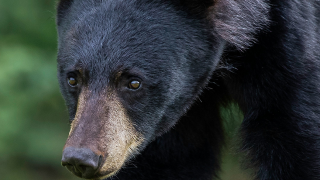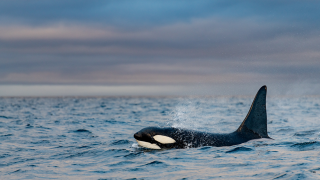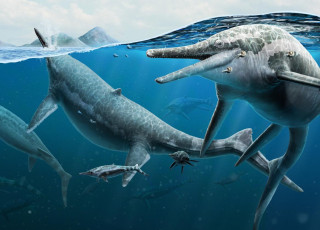The Killer Whale Confusion: Name Origins and Taxonomy
By Olivia Barney
Names are important. They give us a sense of identity, help us know who we’re related to, and can even provide clues of our ancestry. Nicknames are equally important. The ones we like best usually come from loved ones, reference a shared memory, or highlight something about us (an attribute or personality trait) that makes us unique.
But nicknames can also be hurtful, misleading, or ironic — purposeful misnomers that can cause confusion for anyone unaware of the nickname’s origin. For humans, this might result in a bad first impression, a missed opportunity, or an onslaught of teasing (playful or otherwise). For wildlife, the results manifest on a larger, global scale. Misunderstanding a species can lead to a public disinterest or fear of the animal itself. As a result, conservation efforts may suffer. Fewer donations limit research and rehabilitation opportunities. Less research leads to more unanswered questions about the species.
We’ve seen it happen with the orca — the legendary killer whale.

Family of Orcas Swimming
But “killer whale” is a controversial nickname for the black and white mammals. Yes, they are the apex predators of the sea, but they aren’t the ruthless, aggressive creatures that their nickname makes them out to be. For years, orca defenders have pushed back at the title, comparing orca behavior to other predators of the deep and pointing out that orcas aren’t even whales to begin with — they’re dolphins.
This clever defense strategy sparked a new debate on the nickname: are orcas actually whales, or are they dolphins?
The short answer is both. The slightly longer answer is fascinating.
Taxonomic Classification Provides Insight Into Shared Traits
When it comes to living things, we categorize commonly shared traits using a science called taxonomy. Using a taxonomic classification system can look a lot like gazing at a family tree, but rather than identifying generations, we’re pointing out the similarities (shared traits) between species — those key attributes are then used to help researchers categorize life forms big and small.
The seven basic categories (from broadest to most specific) are kingdom, phylum, class, order, family, genus, and species. Most of the time, we use nicknames or “common names” to talk about the world around us. After all, you probably won’t ask your local grocer where to find Malus pumila, but you might ask them to point out the produce section so you can pick up an apple or two.
But understanding scientific names has value. If you were to read a book about bears, for example, they might list Ursus maritimus (polar bear) and Ursus americanus (North American black bear). Though the polar bear is nearly double the size and triple the weight of its smaller relative, they share the same genus — an indication that they also share traits that bears outside of the Ursus genus (like Ailuropoda melanoleuca, the giant panda bear) may not have.
1 of 3
You can dive deeper at every level, with each group above becoming broader and each group below becoming more specific. Putting the orca debate to rest is simple. By looking at the taxonomic classifications of whales, dolphins, and orcas, we can identify when they were separated into individual groups. Best of all, exploring these groupings allows us to better understand some of the characteristics that they share.
Order Cetacea: The Whale and Dolphin Club
Cetacea is the scientific order that encompasses whales, dolphins, and porpoises. It’s an impressive group. The mammals that fall under this category evolved from some kind of terrestrial life (land animal), entering the water and never looking back — meaning their whole lives (mating, giving birth, hunting, etc.) exist within the water. Since an order is a higher-level classification than a genus or species, a lot of species fall under the large Cetacea umbrella.
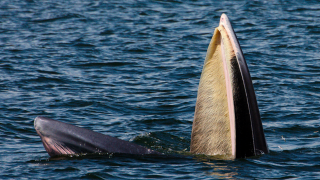
An up-close look at the baleen bristles that filter food for some whales in the Mysticeti sub-order.
In general, it can be separated further into two sub-orders: Mysticeti (baleen whales) and Odontoceti (toothed whales). Baleen is a bristly material made from keratin (the same protein that makes human hair and fingernails). Inside of a whale’s mouth, baleen filters krill and other small pieces of food from the water, eliminating the need for teeth.
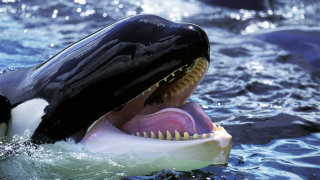
An up-close look at an orca, which displays the conical teeth typical of whales belonging to the Odontoceti sub-order.
While the sub-order Mysticeti features some of the most iconic whales — like blue and humpback whales — Odontoceti is a significantly larger group. This is where sperm whales, belugas, dolphins, orcas, and even narwhals belong.
If we move closer, narrowing our focus on the family level, we reach Delphinidae. Dolphins and orcas fall into this category, and on this level, the family is distinguished by more than just teeth.
Delphinids vary in appearance between species, but there are a handful of similarities that keep them connected. Their long bodies feature prominent dorsal fins, defined snouts or beaks, and cone-shaped teeth. They sport large fatty masses in their foreheads (called melons) that aid them in using echolocation — a tool for direction and communication.
1 of 3
The family level of Delphinidae is the furthest we could descend in taxonomic levels before isolating orcas from the stereotypical dolphins and whales we often think of — Orcinus orca, after all, is the only species within the Orcinus genus.
Where does the nickname “killer whale” come from?
When we look at how whales, dolphins, and orcas are categorized across the taxonomic levels, the answer to the oft-debated topic becomes clear: Orcas are dolphins. Dolphins are toothed whales. So yes, the orca is both a whale and a dolphin.
But if all dolphins, porpoises, and whales technically fall underneath the broader whale umbrella (order Cetacea), why was the orca chosen to receive the “killer whale” nickname? Where did the nickname come from?
One possible answer is found in a story — a legend that explains it all.
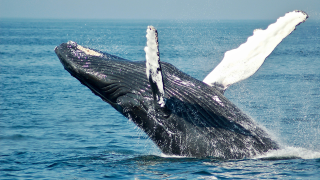
Long ago, a group of sailors were out on the open water. The blue surface of the sea stretched endlessly in all directions. In the distance, a large whale surfaced, but it wasn’t alone.
A group of black and white animals sprung from the sea before diving below the surface once more, harmoniously coordinating their attack on the much larger whale. The sailors watched the ambush unfold in shock and disbelief. Later, after returning to land, the sailors began telling the harrowing tale of an outnumbered attack, the defeat of a powerful whale, and descriptions of the black and white beasts who emerged as victors, earning them a fitting name: the whale killer.

Solo Orca Swimming Adobe Stock Image
Tales of “the whale killer” were passed on over and over again — changing with each retelling until “the whale killer” eventually morphed into “the killer whale.”
The nickname stuck.
Names are powerful, lasting labels for humans and animals alike. The public fear and fascination of “killer whales” throughout the years has had an interesting impact on the entertainment industry as well as research and conservation efforts. These perspectives are explored in our current special exhibition, Orcas: Our Shared Future, which will be on display until April 20, 2025. You can dive deeper today by seeing the splendor for yourself.

Explore the World of Orcas
Dive deeper into the majesty and mystery of orcas — a unique underwater exploration available through April 20, 2025.


